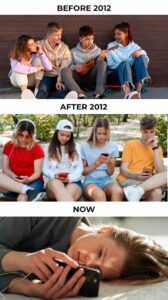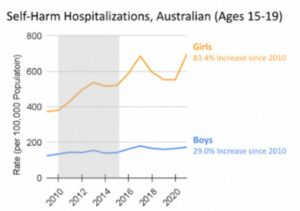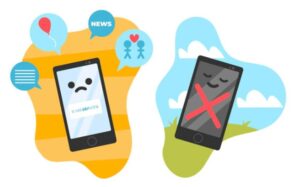I read this article this week and thought it was important I pass it onto our community. Much of what is written here is what I see on a daily basis in my job and what I see more broadly in our community. I agree wholeheartedly with the recommendations outlined at the end of this article and whilst I acknowledge they are hard to implement, I think we have a collective responsibility to try.
It would be comforting if there was room to argue with the data social psychologist Jonathan Haidt presented to a conference in London earlier this month. Sadly, there is not. We were not jumping at shadows when we suspected that ubiquitous access to social media had fundamentally reshaped childhood in mostly damaging ways.
Something happened across the Western world a decade ago when teenagers began using smartphones in significant numbers.
“If you plot out the trend lines for depression and anxiety, self-harm, and suicide, they’re relatively flat until 2010,” Haidt told the conference. “And then all over the English-speaking world, they start shooting up around 2012, plus or minus a year.”

Suicide rates are at peak levels across the Anglosphere and Nordic countries, for teenage girls. Not all are at equal risk. For kids who are religious conservatives, mental health conditions have hardly changed. For girls on the left and secular conservatives less grounded in traditional values, it is a very different picture.
The number of girls aged between 15 and 19 hospitalised for self-harm has increased by 78 per cent since 2010 in Australia. In the US, the number of 10-14 year old girls admitted to hospital for non-fatal self-harm rose by 188 per cent in the same period. The trend is consistent in every jurisdiction where data is available.
“This is the biggest mental health crisis in known history for kids,” said Haidt. “The increased number of suicides since 2010 is so large that I suspect this is among the largest public health threats to children since the major diseases were wiped out.”

Haidt distinguishes between social media primarily used for networking, like Facebook and LinkedIn, and those that serve as platforms on which kids are compelled to perform.
“Social media platforms should never be accessed by children until they’re 18,” Haidt said. “It’s just insane that we let kids do these things that can ruin their lives.”
He singles out Instagram as the worst platform for bullying and TikTok as the worst for their intellectual development.
“It literally reduces their ability to focus on anything while stuffing them with little bits of stuff that was selected by an algorithm for emotional arousal,” Haidt said. He declares TikTok and Twitter incompatible with liberal democracy as it’s developed over the last few hundred years.
Yet access to social media is not the only behavioural change encouraged by smartphones.
“For all of human history, for millions of years, all mammals play,” Haidt said. “Mammal childhood is about building up your brain, and you do that through play.

“Once they all got phones, childhood stopped being play-based. It becomes phone-based.” He notes a significant decline in the habit of kids visiting other kids’ houses to play. Social interactions have become virtual, asynchronous, disembodied and transitory.
Some suggest that the rise in teenage anxiety might be because of greater self-reporting since mental health has been de-stigmatised. Haidt categorically rules that out.
“Right around 2013, in the U. S., Canada, Britain, Australia, and New Zealand, all these girls suddenly start checking in to psychiatric in-patient units.
“They’re making many more suicide attempts. Their level of self-harm goes up by two or three hundred per cent, especially for the younger girls, age ten to fourteen.”
These, says Haidt, are not self-reporting variables. This is real.
“It’s the great rewiring of childhood. It happened between 2010 and 2015. It hit the U. S., Canada, Britain, Australia, New Zealand exactly the same way. New Zealand’s a little bit later, but the US and Canada are exactly in lockstep about what happened to our kid’s mental health.”
Haidt is writing his next book on the subject. Life After Babel is scheduled for publication early next year. In it, he will recommend the introduction of four norms to solve what he says is a collective action problem.

The first: “Don’t give a smartphone to your 10-year-old. Wait until 14.
“Rule number two, no social media before 16.
“The third rule: phone-free schools. That does not mean you can keep it in your backpack. Otherwise, the kids will go to the bathroom. They’ll find ways to get their fix.
“Rule four is far more free play, unsupervised play and childhood independence.
“If we do those four things, and if, even if half of us do them, we solve the collective action problem.”

